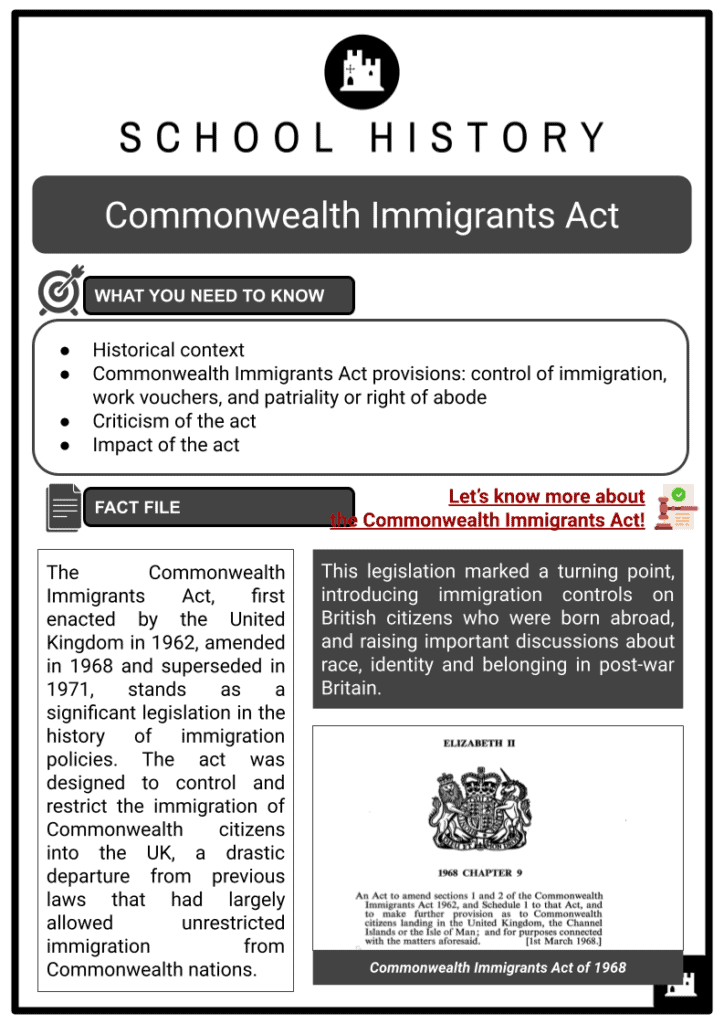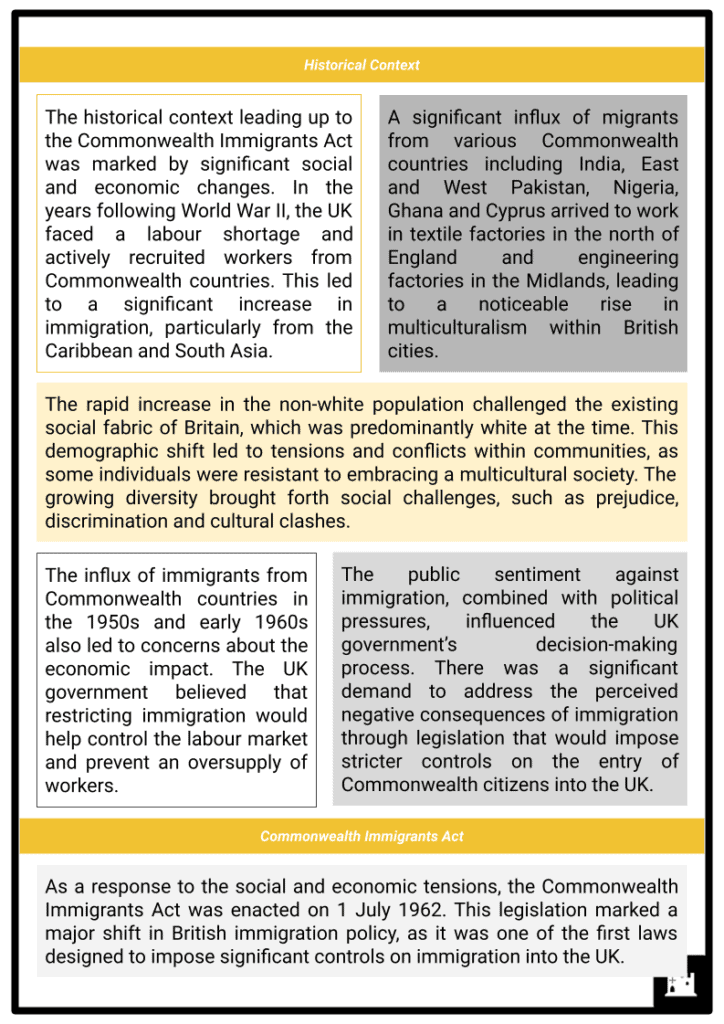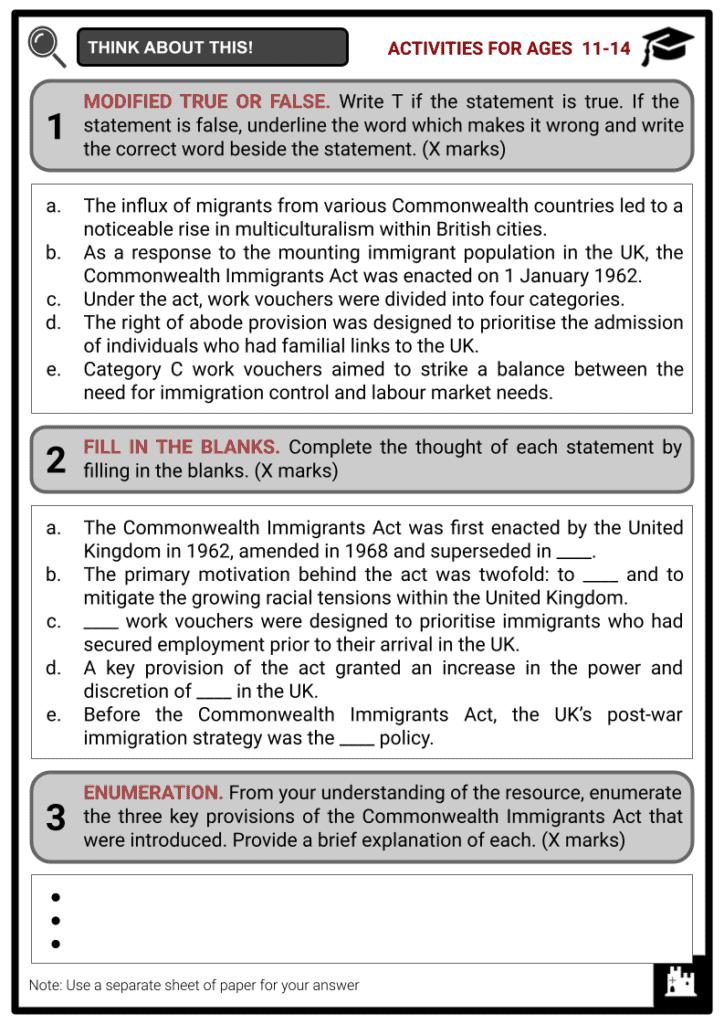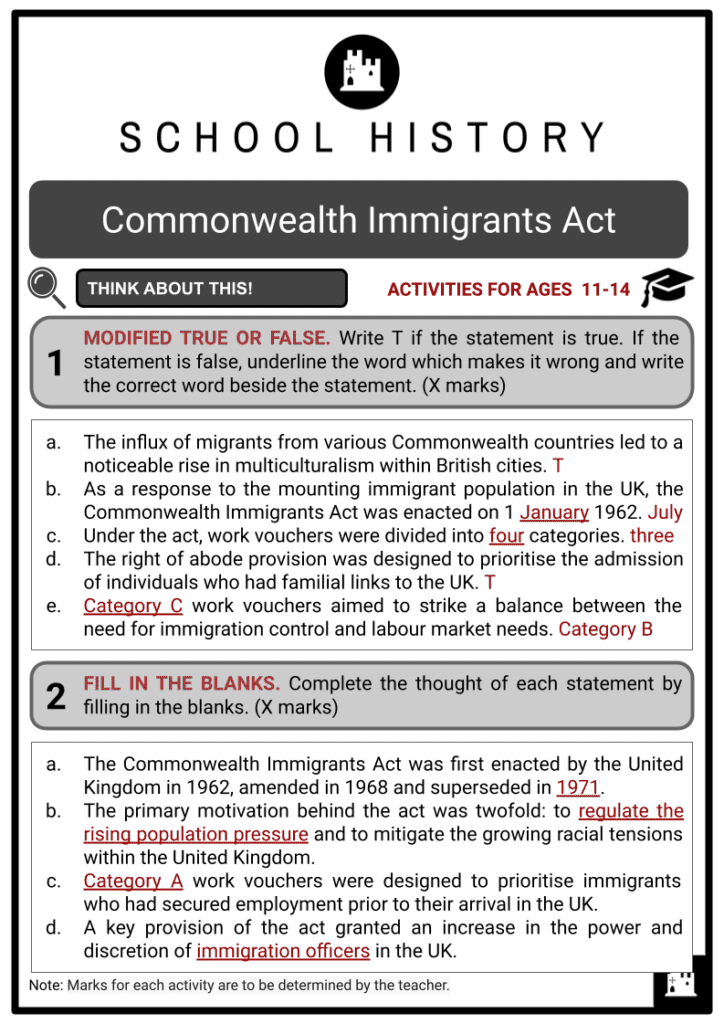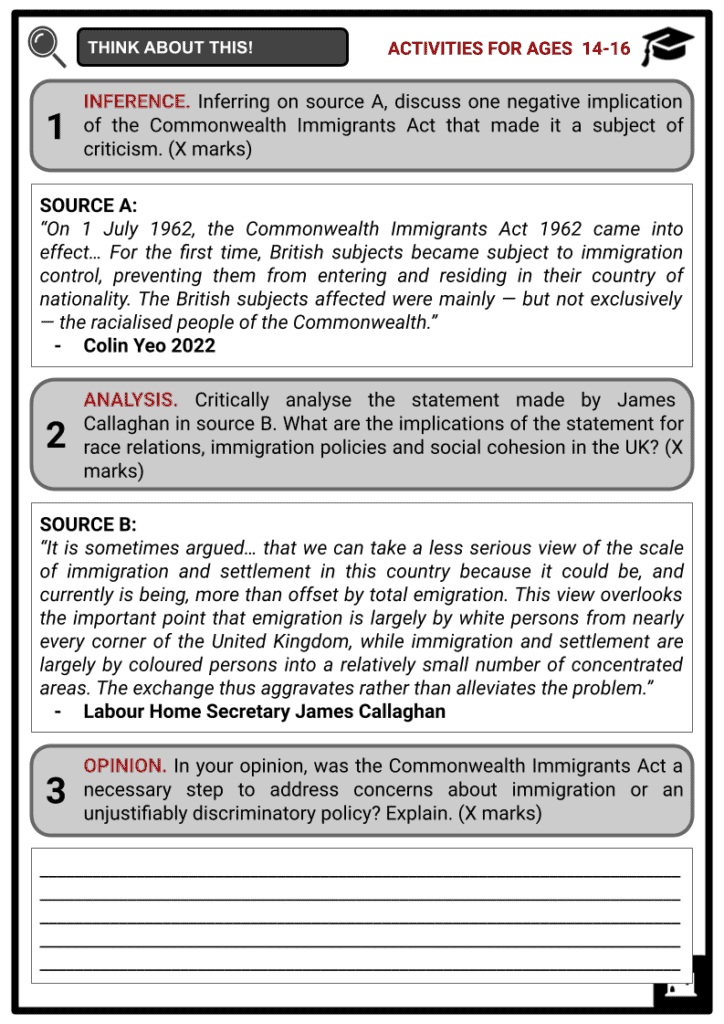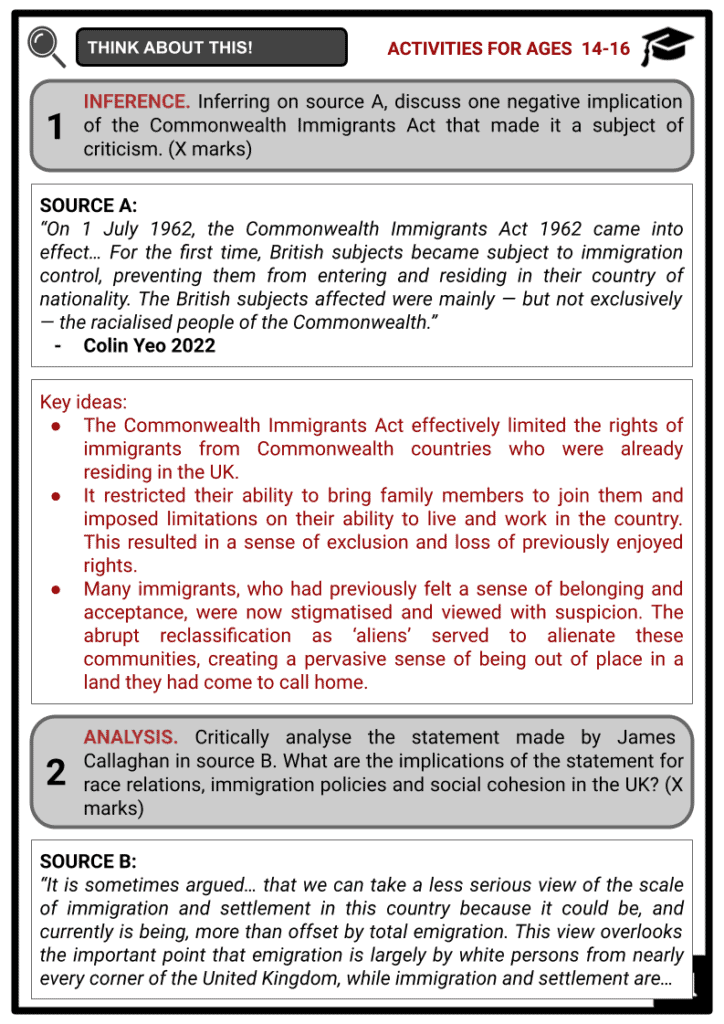Commonwealth Immigrants Act Worksheets
Do you want to save dozens of hours in time? Get your evenings and weekends back? Be able to teach about the Commonwealth Immigrants Act to your students?
Our worksheet bundle includes a fact file and printable worksheets and student activities. Perfect for both the classroom and homeschooling!
Summary
- Historical context
- Commonwealth Immigrants Act provisions: control of immigration, work vouchers, and patriality or right of abode
- Criticism of the act
- Impact of the act
Key Facts And Information
Let’s know more about the Commonwealth Immigrants Act!
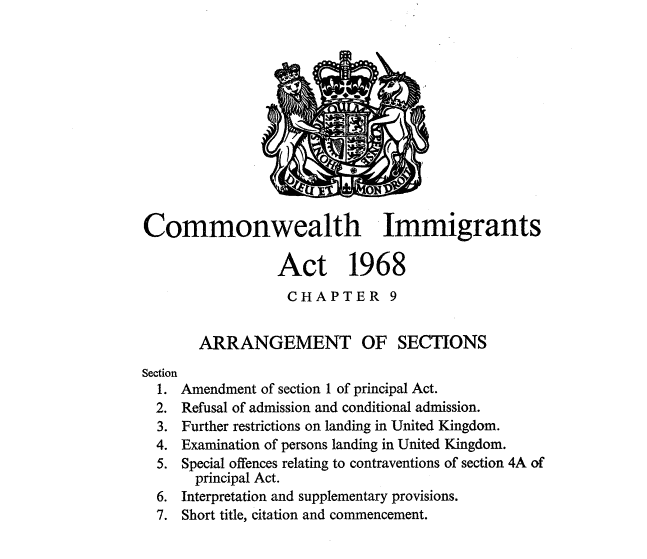
The Commonwealth Immigrants Act, first enacted by the United Kingdom in 1962, amended in 1968 and superseded in 1971, stands as a significant legislation in the history of immigration policies. The act was designed to control and restrict the immigration of Commonwealth citizens into the UK, a drastic departure from previous laws that had largely allowed unrestricted immigration from Commonwealth nations. This legislation marked a turning point, introducing immigration controls on British citizens who were born abroad, and raising important discussions about race, identity and belonging in post-war Britain.
Historical Context
- The historical context leading up to the Commonwealth Immigrants Act was marked by significant social and economic changes. In the years following World War II, the UK faced a labour shortage and actively recruited workers from Commonwealth countries. This led to a significant increase in immigration, particularly from the Caribbean and South Asia.
- A significant influx of migrants from various Commonwealth countries including India, East and West Pakistan, Nigeria, Ghana and Cyprus arrived to work in textile factories in the north of England and engineering factories in the Midlands, leading to a noticeable rise in multiculturalism within British cities.
- The rapid increase in the non-white population challenged the existing social fabric of Britain, which was predominantly white at the time. This demographic shift led to tensions and conflicts within communities, as some individuals were resistant to embracing a multicultural society. The growing diversity brought forth social challenges, such as prejudice, discrimination and cultural clashes.
- The influx of immigrants from Commonwealth countries in the 1950s and early 1960s also led to concerns about the economic impact. The UK government believed that restricting immigration would help control the labour market and prevent an oversupply of workers.
- The public sentiment against immigration, combined with political pressures, influenced the UK government’s decision-making process. There was a significant demand to address the perceived negative consequences of immigration through legislation that would impose stricter controls on the entry of Commonwealth citizens into the UK.
Commonwealth Immigrants Act
- As a response to the social and economic tensions, the Commonwealth Immigrants Act was enacted on 1 July 1962. This legislation marked a major shift in British immigration policy, as it was one of the first laws designed to impose significant controls on immigration into the UK.
- The primary motivation behind the Commonwealth Immigrants Act was twofold: to regulate the rising population pressure and to mitigate the growing racial tensions within the United Kingdom.
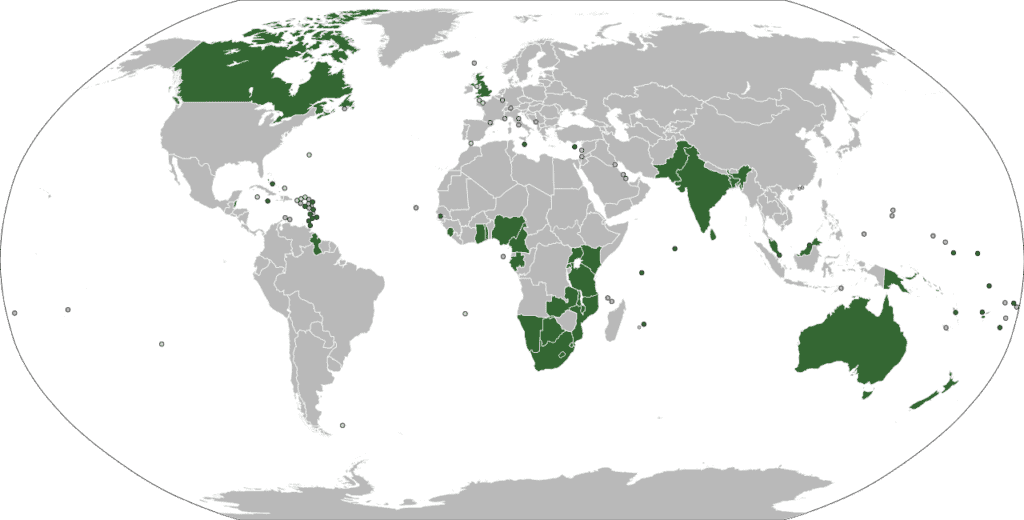
Map showing the members of the Commonwealth of Nations - The unprecedented influx of immigrants had strained the nation's resources and infrastructure, necessitating some form of population control. Moreover, the increase in racial prejudice and discrimination highlighted a pressing need to address issues related to social cohesion and harmony.
- Therefore, the act was seen as a necessary measure to balance the demographic dynamics and foster a more inclusive and harmonious social environment. However, it’s worth noting that this legislation was controversial, as it was criticised for its discriminatory undertone and potential violation of the principle of free movement within the Commonwealth.
- Several key provisions were introduced that significantly limited immigration from the Commonwealth nations. The main provisions revolved around the control of immigration, issuance of work vouchers, and introduction of the right of abode.
Control of Immigration
- Under this provision, immigration officers were provided with the authority to at their discretion question and detain individuals upon their arrival in the UK. They could ascertain the purpose and duration of an individual’s stay and could refuse entry if they were not satisfied with the answers. This provision was initially seen as a vital element in streamlining immigration processes and ensuring that incoming individuals had legitimate reasons for seeking to enter the UK.
- A key provision was introduced under the Commonwealth Immigrants Act of 1962 and this granted an increase in the power and discretion of immigration officers in the UK. It was formulated with the intention of providing these officers with the necessary tools and authority to effectively manage the complex and diverse nature of immigration cases.
- However, this provision was met with considerable criticism. Detractors contended that it gave an inordinate amount of power to immigration officers, potentially leading to misuse or arbitrary decisions.
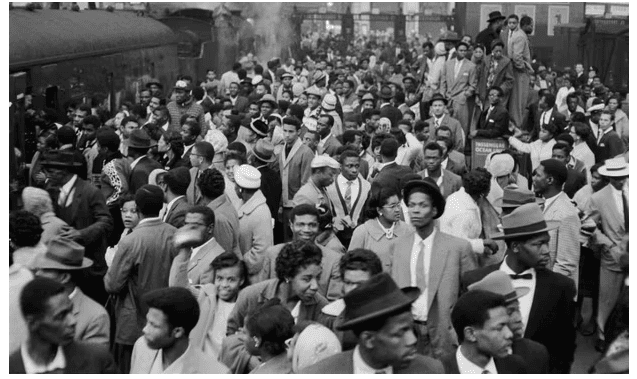
Immigrants at Waterloo, 1961 - Furthermore, critics argued that decisions based on an individual officer’s discretion could be subjective and discriminatory. There were concerns about the lack of transparency and consistency in the decision-making process, considering the potentially life-altering consequences for the individuals affected.
- Supporters, on the other hand, defended the provision as a much-needed measure to ensure the viability of the UK’s immigration policies. They argued that the provision provided immigration officers with the flexibility needed to handle the broad range of cases they encountered, each with distinct circumstances and nuances.
Work Vouchers
- Another key provision introduced in the Commonwealth Immigrants Act of 1962 concerns that of employment vouchers. These work vouchers were divided into categories A, B and C, and were issued as a prerequisite for entry into the UK.
- Category A vouchers were designed to prioritise immigrants who had secured employment prior to their arrival in the UK. The immigration policy took into consideration the need for certain skills within the UK labour market. These vouchers were issued to immigrants who had a specific job offer, and the employer had to prove that they were unable to fill the position locally.
- This ensured that the immigrant workforce did not stifle opportunities for the local population. By allowing entry to those with guaranteed employment, category A vouchers served to control immigration while still addressing the labour market’s needs. This, however, meant that immigrants without a pre-arranged job offer found it significantly more challenging to enter the country.
- Category B vouchers were a middle-ground approach that aimed to strike a balance between the need for immigration control and labour market needs. These vouchers were issued to individuals who, although not having secured employment before they arrived in the UK, possessed skills and qualifications that were deemed desirable or in demand in the UK labour market.
- It allowed the UK to attract a diverse range of skill sets from the Commonwealth nations, contributing to the economic dynamism and cultural richness of the country. However, it also imposed a degree of uncertainty for immigrants who entered under this category, as the lack of pre-arranged employment made their economic stability and integration into society more challenging.
- Category C vouchers represented the most liberal tier within the UK’s immigration policy, set in place to accommodate immigrants irrespective of their employment status or qualifications. These vouchers were granted to individuals who, while not necessarily possessing a specific job offer or a desirable skill set, wanted to migrate to the UK for a range of personal reasons, including the desire for a better life, family connections or political stability.
- While this category allowed for a wider scope of immigration, it also became a point of contention due to its potential for abuse and the challenges it posed for integration and social cohesion.
Patriality or Right of Abode
- Under the Immigration Act 1971, patriality or the right of abode was introduced. This provision was designed to prioritise the admission of individuals who had direct personal or familial links to the UK, thereby changing the dynamics of immigration from Commonwealth countries.
- Under the patriality provision, the right to enter and stay in the UK was no longer extended to all Commonwealth citizens but was restricted to those who had a parent or grandparent born in the UK. This provision effectively distinguished between immigrants who had a ‘patrial’ connection to the UK and those who did not, resulting in a significant shift in the demographics of immigration.
- The main objective of the patriality provision was to manage the volume and diversity of immigrants entering the UK. However, it was met with stark criticism. Critics argued that it was discriminatory, as it largely affected individuals from new Commonwealth countries, typically those with predominantly non-white populations. This racial undertone was a source of controversy, leading to criticisms of the provision as being inherently biased and unjust.
- Conversely, advocates of the provision hailed it as a necessary measure to control the influx of immigrants and ensure smoother integration into society. They argued that those with a ‘patrial’ connection would find it easier to assimilate due to pre-existing cultural and familial links.
Criticism of the Act
- The Commonwealth Immigrants Act has been the subject of significant criticism since its enactment. Born out of a period of political and social tension, the act represented a shift away from the inclusive immigration policy that had previously existed.
- The act primarily aimed to control the immigration of citizens from Commonwealth countries, placing restrictive measures that were not well received. One of the main criticisms levelled against it was that it was inherently discriminatory.
- The act was built on the principle of favouring immigrants from ‘Old Commonwealth’ countries – predominantly white nations such as Australia, New Zealand and Canada – over those from the ‘New Commonwealth’ nations, which comprised mainly of individuals from Asian and African countries. This put in place a racially infused hierarchy within the immigration system, whereby the colour of one’s skin implicitly determined one’s mobility and freedom to migrate to the UK. The act effectively curtailed the rights of non-white Commonwealth citizens, thereby institutionalising racial discrimination.
- Moreover, critics argue that the act was enacted in response to unfounded fears and misconceptions about immigrants.
- The predominant fear was that immigrants, particularly from ‘New Commonwealth’ countries, would create undue pressure on public services such as healthcare, housing and education. This was despite substantial evidence suggesting that immigrants often contribute more to the economy than they take in public services.
- Another commonly held misconception was that immigrants would ‘steal’ jobs from UK citizens, thereby increasing unemployment rates. However, numerous studies have shown that immigration does not have a significant impact on unemployment rates and can potentially lead to economic growth. Unfortunately, these fears and misconceptions, often reinforced by certain sections of the media, led to a harmful narrative that immigrants were a burden rather than a boon.
- The act also had negative implications for the immigrant community already living in the UK. Many immigrants, who had previously felt a sense of belonging and acceptance, were now stigmatised and viewed with suspicion. The abrupt reclassification as ‘aliens’ served to alienate these communities, creating a pervasive sense of being out of place in a land they had come to call home.
- This psychological dislocation often led to a deep sense of rootlessness and insecurity. Moreover, these feelings were oftentimes aggravated by the lack of social support, as the act coincided with a period of rising xenophobia and racism. Even the subsequent generations, born and brought up in the UK, lived under the shadow of this alienation, coping with a sense of identity crisis and belonging. The enduring legacy of the act, therefore, is not just the restriction of rights and mobility, but a profound emotional and psychological scar on these communities.
Impact of the Act
- The Commonwealth Immigrants Act has had a profound and diverse impact, significantly shaping the immigration landscape of the UK for several decades. The act significantly increased the number of individuals who migrated to the UK from Commonwealth countries, fostering a more diverse and multicultural society.
- This diversity enriched the UK’s cultural, economic and social spheres, contributing to its vibrancy and dynamism. However, the act also led to increased instances of racial discrimination and social tensions. The discretionary powers conferred upon immigration officers led to allegations of racial profiling and discriminatory practices. Many immigrants from the Commonwealth became victims of xenophobia and racism, leading to their marginalisation within society.
- Economically, the act had both positive and negative impacts. On the one hand, it led to an influx of skilled workers who contributed significantly to the UK’s economic growth. On the other hand, it also led to an increased strain on public services, particularly in areas of high immigrant concentration.
- From a political perspective, the act has been a source of contention and debate. Its introduction marked a significant shift in the UK’s immigration policy, moving away from the open-door policy that had characterised its post-war immigration strategy. This shift continues to influence political discourse and policy decisions related to immigration today.
- The Commonwealth Immigrants Act has had a lasting impact on the UK’s immigration landscape. Its traces can be seen in the socio-cultural fabric, the economic milieu and the political sphere. It remains a potent symbol of the complexities and challenges associated with immigration policy.
Frequently Asked Questions
- What was the Commonwealth Immigrants Act?
The Commonwealth Immigrants Act was passed by the United Kingdom in 1962. It was aimed at restricting the immigration of citizens from Commonwealth countries to the UK. Commonwealth citizens who did not have a parent or a grandparent born in the UK were required to obtain a work voucher before they could enter the country.
- Which countries were affected by the Commonwealth Immigrants Act?
Citizens of Commonwealth countries, which included former territories of the British Empire, were affected by the Act. This included countries like India, Pakistan, Nigeria, Jamaica, and others.
- Why was the Commonwealth Immigrants Act implemented?
The Act was implemented due to concerns about the increasing number of immigrants from Commonwealth countries settling in the UK. The British government wanted to control immigration and imposed restrictions to regulate the influx of immigrants.

